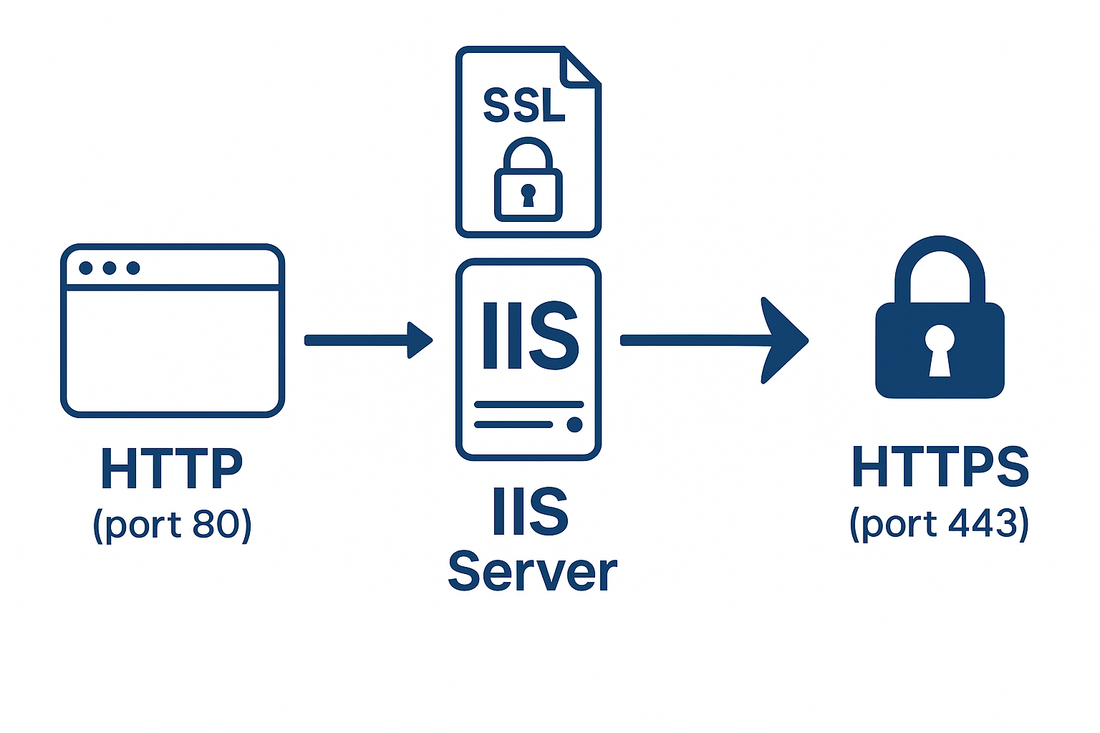
Redirecting HTTP to HTTPS in IIS Microsoft 7X and Higher
Daniel MartinezShare
Implementing proper HTTP to HTTPS redirection in Microsoft IIS 7.X and higher versions is a critical step in securing your web infrastructure.
This guide provides system administrators and SSL Certificate professionals with instructions for configuring secure redirections that maintain SEO rankings, preserve user experience, and ensure complete security coverage across your Microsoft server environment.
When you deploy SSL Certificates on your IIS server, establishing automatic HTTP to HTTPS redirection becomes essential for maximizing security benefits.
Without proper redirection, users may inadvertently access unsecured versions of your website, potentially exposing sensitive data and undermining the protection provided by your SSL Certificate investment.
Understanding HTTP to HTTPS Redirection
HTTP to HTTPS redirection serves as the bridge between unsecured and secured connections on your Microsoft IIS server.
When visitors attempt to access your website using HTTP protocol, the redirection mechanism automatically forwards them to the HTTPS version, ensuring they benefit from the encryption and authentication provided by your Trustico® SSL Certificate.
The redirection process involves several critical components that must work together seamlessly. Your IIS server must recognize incoming HTTP requests, evaluate the security requirements, and execute the appropriate redirect response while preserving the original request parameters, query strings, and intended destination paths.
Trustico® SSL Certificates provide the foundation for this secure communication by establishing encrypted channels between web browsers and your IIS server. Our SSL Certificates support all modern encryption standards, including TLS 1.2 and TLS 1.3, ensuring compatibility with current security requirements and future-proofing your implementation.
Prerequisites for IIS HTTP to HTTPS Redirection
Before implementing HTTP to HTTPS redirection on your Microsoft IIS 7.X or higher server, ensure you have properly installed and configured your Trustico® SSL Certificate.
The SSL Certificate must be bound to your website through the IIS Manager, with the SSL Certificate chain properly established and all intermediate SSL Certificates correctly installed.
Verify that your Trustico® SSL Certificate or Sectigo® branded SSL Certificate is functioning correctly by accessing your website directly via HTTPS. Test the SSL Certificate installation using the SSL tools available on our website to confirm proper chain validation, encryption strength, and protocol support. Any issues with the SSL Certificate installation must be resolved before implementing redirection rules.
Your IIS server should be running Microsoft IIS version 7.0 or higher, with appropriate administrative privileges for modifying server configurations.
Ensure you have backup procedures in place before making configuration changes, as improper redirection rules can impact website accessibility and user experience.
Method 1 : Implementing HTTP to HTTPS Redirection Using IIS URL Rewrite Module
The IIS URL Rewrite Module provides the most flexible and comprehensive solution for implementing HTTP to HTTPS redirection. This method offers precise control over redirection behavior, supports complex rule conditions, and maintains SEO-friendly redirect responses that preserve search engine rankings.
Begin by downloading and installing the URL Rewrite Module from the Microsoft IIS website. The module integrates seamlessly with IIS Manager, providing a graphical interface for creating and managing rewrite rules. After installation, the URL Rewrite feature appears in the IIS section of your server management interface.
Configure your Trustico® SSL Certificate binding in IIS Manager by selecting your website, accessing the Bindings option, and ensuring your SSL Certificate is properly associated with port 443. Verify that the SSL Certificate chain is complete and that the binding includes the correct hostname or Wildcard configuration for your domain requirements.
Create the HTTP to HTTPS redirection rule by opening the URL Rewrite module in IIS Manager. Add a new blank rule and configure the following parameters : set the rule name to "HTTP to HTTPS Redirect", configure the match URL pattern to (.*) to capture all incoming requests, and establish conditions that trigger the redirection only for HTTP traffic.
The condition configuration requires adding an input parameter {HTTPS} with a pattern value of off and ignore case enabled. This condition ensures the redirection rule activates only when the incoming request uses HTTP protocol, preventing redirect loops and maintaining proper HTTPS traffic flow.
Configure the action section with redirect type set to Permanent (301) for SEO benefits, and set the redirect URL to https://{HTTP_HOST}/{R:1}. This configuration preserves the original hostname and request path while redirecting to the secure HTTPS version protected by your Trustico® SSL Certificate.
For advanced implementations, you can modify the web.config file directly by adding the following XML configuration within the system.webServer section :
<rewrite> <rules> <rule name="HTTP to HTTPS redirect" stopProcessing="true"> <match url="(.*)" /> <conditions> <add input="{HTTPS}" pattern="off" ignoreCase="true" /> </conditions> <action type="Redirect" url="https://{HTTP_HOST}/{R:1}" redirectType="Permanent" /> </rule> </rules> </rewrite>
Method 2 : ASP-Based HTTP to HTTPS Redirection for IIS Servers
The ASP-based redirection method provides a server-side scripting solution for implementing HTTP to HTTPS redirection when the URL Rewrite Module is not available or when you prefer programmatic control over the redirection logic. This approach works effectively with Trustico® SSL Certificates and provides flexibility for custom redirection scenarios.
Create a new ASP file named redirect.asp in your website root directory. This file will serve as the redirection handler, examining incoming requests and determining whether HTTPS redirection is necessary. The script must evaluate server variables to identify the current protocol and construct appropriate HTTPS URLs for redirection.
Implement the following ASP code structure to handle HTTP to HTTPS redirection : check the HTTPS server variable to determine the current connection security status, construct the secure URL using the HTTP_HOST and REQUEST_URI server variables, and execute the redirection using Response.Redirect with the appropriate status code.
The complete ASP redirection code should include error handling and logging capabilities :
<% If Request.ServerVariables("HTTPS") = "off" Then Response.Status = "301 Moved Permanently" Response.Redirect "https://" & Request.ServerVariables("HTTP_HOST") & Request.ServerVariables("REQUEST_URI") End If %>
Configure IIS to use the redirect.asp file as the default document for your website by modifying the Default Document settings in IIS Manager. This ensures that all HTTP requests are processed through the redirection logic before serving content, maintaining security coverage across your entire website.
Test the ASP-based redirection thoroughly by accessing various pages on your website using HTTP URLs. Verify that the redirection preserves query strings, maintains proper status codes, and successfully redirects users to the HTTPS version.
Advanced Configuration Options for Trustico® SSL Certificate Implementations
Advanced HTTP to HTTPS redirection configurations with Trustico® SSL Certificates may require additional considerations for complex server environments. Multi Domain SSL Certificates, Wildcard SSL Certificates, and load-balanced configurations each present unique redirection challenges that require specialized approaches.
When implementing Trustico® Wildcard SSL Certificates, ensure your redirection rules accommodate subdomain variations and maintain proper SSL Certificate coverage across all redirected requests. The redirection logic must preserve subdomain information while ensuring the Wildcard SSL Certificate can validate the resulting HTTPS connections.
For websites using Trustico® Multi Domain SSL Certificates, configure redirection rules that account for all covered domains and subdomains. Each domain included in the SSL Certificate should have corresponding redirection rules that maintain proper SSL Certificate validation and user experience consistency.
Load-balanced environments require special attention to ensure HTTP to HTTPS redirection works correctly across all server nodes. Configure redirection rules on each server instance, and verify that load balancer settings properly handle HTTPS traffic distribution while maintaining SSL Certificate session affinity.
SEO Considerations and Best Practices for HTTPS Migration
Implementing HTTP to HTTPS redirection with Trustico® SSL Certificates requires careful attention to SEO implications and search engine optimization best practices. Proper redirection configuration ensures that search engine rankings transfer successfully to your secure HTTPS pages while maintaining user experience and site functionality.
Use 301 permanent redirects for all HTTP to HTTPS redirection to signal to search engines that the HTTPS version is the canonical URL. This redirect status code transfers link equity and ranking signals from HTTP pages to their HTTPS counterparts, preserving your search engine optimization investments.
Update your website's internal linking structure to use HTTPS URLs exclusively, reducing the number of redirects users encounter when navigating your site. Internal links should point directly to HTTPS versions of pages, minimizing redirect chains and improving page load performance.
Configure canonical tags on all pages to specify the HTTPS version as the preferred URL, reinforcing the redirection signals and ensuring search engines index the secure versions of your content. This approach works to establish trust and security credibility with search engines.
Testing and Validation Procedures
Comprehensive testing of your HTTP to HTTPS redirection implementation ensures proper functionality across all user scenarios and browser configurations. Testing procedures should verify redirection behavior, SSL Certificate validation, and user experience consistency throughout your website.
Test redirection functionality using multiple browsers and devices to ensure compatibility across different user environments. Verify that redirections work correctly for direct URL access, bookmark navigation, and external link references, maintaining security coverage regardless of how users access your website.
Use our SSL Certificate tools to validate that your Trustico® SSL Certificate or Sectigo® branded SSL Certificate functions correctly after implementing redirection rules. These tools verify SSL Certificate chain validation, encryption strength, and protocol support, ensuring your security implementation meets current standards.
Monitor website performance metrics after implementing HTTP to HTTPS redirection to identify any performance impacts or user experience issues. Page load times, bounce rates, and conversion metrics should remain stable or improve following the security enhancement provided by your Trustico® SSL Certificate implementation.
Troubleshooting Common Redirection Issues
Common issues with HTTP to HTTPS redirection in IIS environments can impact user experience and security coverage. Understanding these issues and their solutions ensures smooth operation and maintains the security benefits of your SSL Certificate investment.
Redirect loops occur when redirection rules create circular references between HTTP and HTTPS versions of pages. This issue typically results from misconfigured conditions in URL rewrite rules or conflicting redirection logic in multiple configuration locations. Resolve redirect loops by reviewing all redirection rules and ensuring conditions properly identify HTTP traffic.
Mixed content warnings appear when HTTPS pages load HTTP resources, undermining the security provided by your Trustico® SSL Certificate. Identify and update all internal references to use HTTPS URLs, including images, stylesheets, scripts, and embedded content that may trigger browser security warnings.
SSL Certificate binding issues can prevent proper HTTPS functionality and cause redirection failures. Verify that your SSL Certificate is correctly bound to the appropriate website and port configuration in IIS Manager, with proper hostname matching and SSL Certificate chain validation.
Monitoring and Maintenance Requirements
Ongoing monitoring and maintenance of HTTP to HTTPS redirection ensures continued security coverage and optimal performance. Regular monitoring identifies potential issues before they impact users and maintains the integrity of your security implementation.
Monitor SSL Certificate expiration dates and renewal requirements to prevent service interruptions that could affect redirection functionality. Trustico® provides management tools and renewal notifications to help maintain continuous security coverage and avoid unexpected SSL Certificate expiration issues.
Review server logs regularly to identify any redirection errors, failed HTTPS connections, or unusual traffic patterns that might indicate security issues or configuration problems. Log analysis helps optimize redirection performance and identify opportunities for improvement.
Implement automated monitoring solutions that alert you to SSL Certificate issues, redirection failures, or security vulnerabilities that could compromise your website security. Proactive monitoring ensures rapid response to potential issues and maintains user confidence in your secure website implementation.
Maximizing Security Benefits with Trustico® SSL Certificates
Proper HTTP to HTTPS redirection maximizes the security benefits provided by Trustico® SSL Certificates, ensuring comprehensive protection for your website visitors and sensitive data. Our SSL Certificates provide industry-leading encryption, authentication, and trust indicators that enhance user confidence and protect against cyber threats.
Trustico® offers a comprehensive range of SSL Certificate options, including Domain Validation (DV), Organization Validation (OV), and Extended Validation (EV) SSL Certificates, each designed to meet specific security requirements and validation levels.
The combination of proper HTTP to HTTPS redirection and high-quality Trustico® SSL Certificates creates a robust security foundation that protects user data, maintains search engine rankings, and demonstrates your commitment to cybersecurity best practices.



